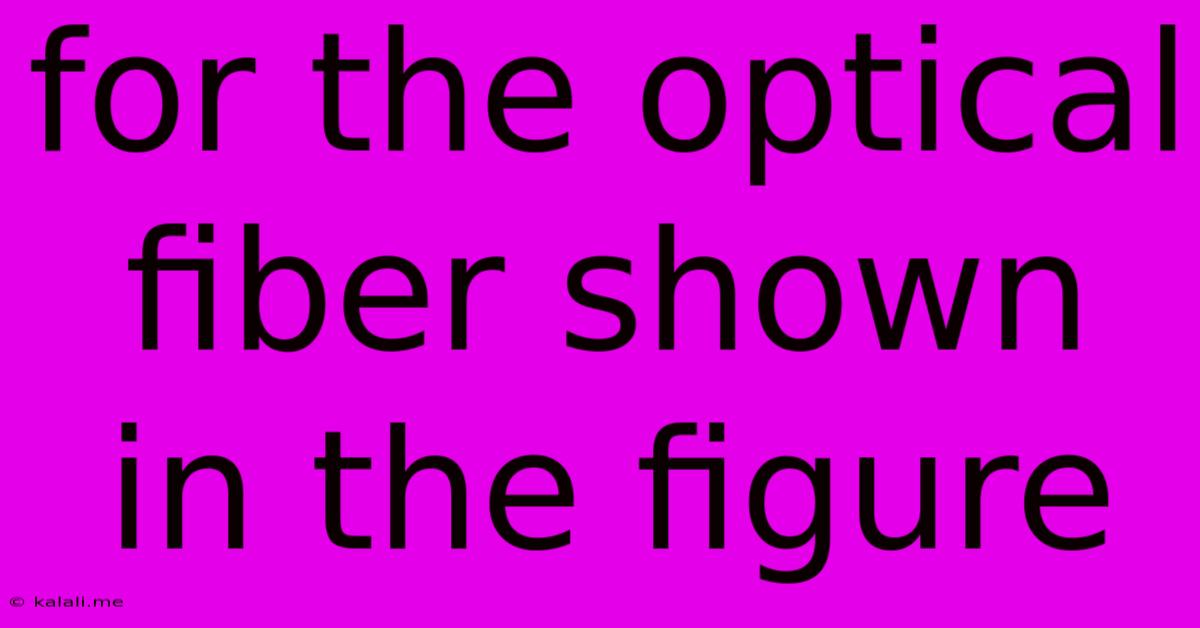For The Optical Fiber Shown In The Figure
Kalali
Jun 15, 2025 · 4 min read

Table of Contents
Understanding the Optical Fiber Shown in the Figure: A Deep Dive into Fiber Optics
This article delves into the structure and functionality of a typical optical fiber, explaining its components and the principles behind its light-transmitting capabilities. We'll cover everything from the core and cladding to the different types of optical fibers and their applications. Understanding the intricacies of optical fiber is crucial in today's digital world, where high-speed data transmission is paramount.
The Anatomy of an Optical Fiber
An optical fiber, at its simplest, is a thin, flexible strand of glass or plastic designed to guide light signals over long distances with minimal loss. Its structure is remarkably simple yet incredibly effective. The key components include:
-
Core: The central part of the fiber, made of high-purity glass or plastic. This is where the light signal propagates. The core's diameter is typically a few micrometers. The refractive index of the core is slightly higher than that of the cladding.
-
Cladding: A layer of glass or plastic surrounding the core. It has a lower refractive index than the core, facilitating total internal reflection. This prevents light leakage from the core, ensuring efficient signal transmission.
-
Coating: A protective layer, usually made of a polymer material, surrounding the cladding. This protects the fiber from damage during handling and installation. This layer provides durability and abrasion resistance.
Total Internal Reflection: The Engine of Optical Fiber Communication
The fundamental principle behind optical fiber's ability to transmit light over long distances is total internal reflection (TIR). When light travels from a medium with a higher refractive index (the core) to a medium with a lower refractive index (the cladding), at an angle greater than the critical angle, it is reflected back into the higher-refractive-index medium. This process repeats continuously, guiding the light along the fiber's length. The efficiency of TIR is crucial for minimizing signal attenuation.
Types of Optical Fibers
Optical fibers are categorized into several types based on their core size and refractive index profile:
-
Single-mode fibers: These fibers have a very small core diameter (around 8-10 micrometers), allowing only one mode of light propagation. This results in low signal dispersion and allows for transmission of signals over much longer distances with higher bandwidths compared to multi-mode fibers. Single-mode fibers are ideal for long-haul telecommunications and high-speed data networks.
-
Multi-mode fibers: These fibers have a larger core diameter (around 50-100 micrometers), allowing multiple modes of light propagation. This leads to higher signal dispersion, limiting their transmission distance and bandwidth compared to single-mode fibers. However, multi-mode fibers are generally less expensive and easier to work with. They're commonly used in shorter-distance applications like local area networks (LANs).
-
Step-index fibers: These fibers have a core with a uniform refractive index, exhibiting a sharp change in refractive index at the core-cladding boundary.
-
Graded-index fibers: These fibers have a refractive index that gradually decreases from the center of the core to the cladding. This gradual change reduces modal dispersion, allowing for better signal transmission over longer distances than step-index multi-mode fibers.
Applications of Optical Fibers
The versatility of optical fibers makes them indispensable in various applications:
-
Telecommunications: Optical fibers form the backbone of modern telecommunication networks, enabling high-speed data transmission across continents.
-
Cable Television: Optical fibers deliver television signals to homes, offering high-bandwidth capabilities for improved picture quality and enhanced services.
-
Local Area Networks (LANs): Optical fibers are increasingly used in LANs for high-speed data transfer within buildings and campuses.
-
Sensors: Optical fibers are used in various sensing applications, including temperature, pressure, and strain sensing.
-
Medical Applications: Optical fibers are employed in medical procedures such as endoscopy and laser surgery.
Conclusion
The optical fiber, with its seemingly simple structure, represents a remarkable technological advancement. Its ability to efficiently transmit light signals over long distances with minimal loss is essential for our increasingly interconnected world. Understanding the different types of optical fibers and their underlying principles is key to appreciating their crucial role in modern communication and various other fields. Further research into fiber optic technologies continues to push the boundaries of data transmission speed and capacity.
Latest Posts
Latest Posts
-
What Is The Largest Satellite In Our Solar System
Jun 15, 2025
-
What Is The Lcm Of 18 And 45
Jun 15, 2025
-
Which Of The Following Is Not A Goal Of Science
Jun 15, 2025
-
What Is The Prime Factorization Of 420
Jun 15, 2025
-
Arrange The Following In The Correct Sequence
Jun 15, 2025
Related Post
Thank you for visiting our website which covers about For The Optical Fiber Shown In The Figure . We hope the information provided has been useful to you. Feel free to contact us if you have any questions or need further assistance. See you next time and don't miss to bookmark.